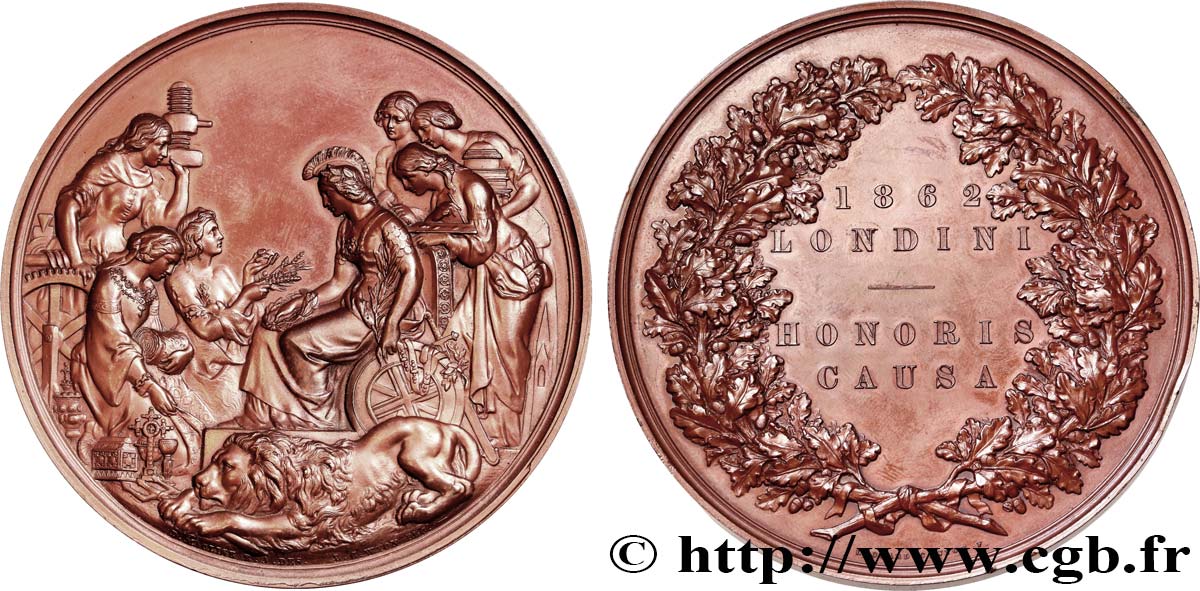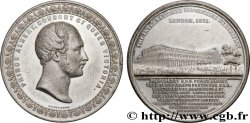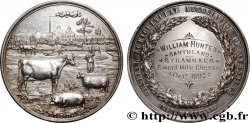fme_423854 - GREAT-BRITAIN - VICTORIA Médaille, Exposition Universelle de Londres
Not available.
Item sold on our e-shop (2018)
Price : 160.00 €
Item sold on our e-shop (2018)
Price : 160.00 €
Type : Médaille, Exposition Universelle de Londres
Date: 1862
Mint name / Town : UK, Londres
Metal : bronze
Diameter : 76,5 mm
Orientation dies : 12 h.
Engraver WYON Leonard Charles (1826-1891)
Weight : 222 g.
Edge : lisse + C. GRAVIER. CLASS XXII.
Coments on the condition:
Superbe médaille avec une très belle patine bien homogène
Obverse
Obverse legend : ANÉPIGRAPHE.
Obverse description : Britannia assise à gauche, un lion à ses pieds, entre plusieurs jeunes filles représentant les produits du Commerce et de l'Industrie.
Reverse
Reverse legend : 1862 / LONDINI / HONORIS / CAUSA.
Reverse description : Couronne de chêne, au centre légende en quatre lignes.
Commentary
Tranche inscrite en creux C. GRAVIER. CLASS XXII.
Signée au droit D. MACLISE R. A. DES. LEONARD C. WYON FEC.et L. C. WYON. FEC. au revers.
Leonard Charles Wyon (1826-1891) était un graveur britannique, réputé pour ses monnaies d’or et d’argent frappées pour la reine Victoria en 1887 et la monnaie de bronze, en usage de 1860 à 1894.
L’Exposition universelle de 1862 se tint à Londres du 1er mai au 1er novembre 1862. Outre les jardins de la Royal Horticultural Society, dans South Kensington, elle occupait l'emplacement des actuels Musée d'histoire naturelle de Londres et Science Museum..
Edge inscribed intaglio C. GRAVIER. CLASS XXII. Signed on the obverse D. MACLISE RA DES. LEONARD C. WYON FEC. and LC WYON. FEC. on the reverse. Leonard Charles Wyon (1826-1891) was a British engraver, renowned for his gold and silver coins struck for Queen Victoria in 1887 and the bronze coinage, in use from 1860 to 1894. The 1862 Great Exhibition was held in London from 1 May to 1 November 1862. In addition to the gardens of the Royal Horticultural Society, in South Kensington, it occupied the site of the present Natural History Museum in London and the Science Museum.
Signée au droit D. MACLISE R. A. DES. LEONARD C. WYON FEC.et L. C. WYON. FEC. au revers.
Leonard Charles Wyon (1826-1891) était un graveur britannique, réputé pour ses monnaies d’or et d’argent frappées pour la reine Victoria en 1887 et la monnaie de bronze, en usage de 1860 à 1894.
L’Exposition universelle de 1862 se tint à Londres du 1er mai au 1er novembre 1862. Outre les jardins de la Royal Horticultural Society, dans South Kensington, elle occupait l'emplacement des actuels Musée d'histoire naturelle de Londres et Science Museum..
Edge inscribed intaglio C. GRAVIER. CLASS XXII. Signed on the obverse D. MACLISE RA DES. LEONARD C. WYON FEC. and LC WYON. FEC. on the reverse. Leonard Charles Wyon (1826-1891) was a British engraver, renowned for his gold and silver coins struck for Queen Victoria in 1887 and the bronze coinage, in use from 1860 to 1894. The 1862 Great Exhibition was held in London from 1 May to 1 November 1862. In addition to the gardens of the Royal Horticultural Society, in South Kensington, it occupied the site of the present Natural History Museum in London and the Science Museum.








 Report a mistake
Report a mistake Print the page
Print the page Share my selection
Share my selection Ask a question
Ask a question Consign / sell
Consign / sell
 Full data
Full data









